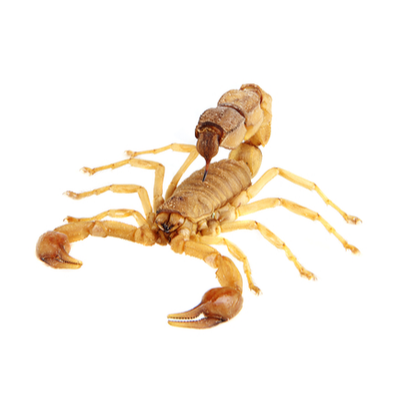
Color: Scorpion adults are yellowish brown to tan, sometimes with stripes or other markings. Newly born 1st instars nymphs are whitish, and stay light in color for about 2-3 months.
Size: Scorpions in the adult stage are about 2-4 in (20-100 mm) long.
Prime locations where they might nest or hide includes under rocks, mulch comprised of pine straw, wood chips or compost, logs, flower bed coverings made of vinyl and other weed reducing material, railroad ties, patio slabs and just about anything found in and around the home which is part of the landscape.
They have poor eyesight, so they do not stalk or chase prey but lie in waiting to grab it with their pincers. Small insects are eaten immediately, but larger prey are stung and eaten after they cease to struggle.
Prime food targets include roaches, centipedes, spiders, ants, grasshoppers and other ground dwelling insects. However, most any scorpion will readily accept a termite if they had to make a choice. This is thought to be true since termites are so fleshy, nutritious and bountiful. For this reason, scorpions tend to be attracted to areas which are moist, shady and full of insects – classic conditions for most any insect population – especially termites.
The venom of most scorpions is rather mild, with reactions not spreading beyond the sting site. Initially there is a burning sensation followed by swelling and discoloration. Local reaction varies from slight swelling to pronounce painful swelling with discoloration and severe burning, but allergic reaction occurs rarely.
In contrast, stings of the deadly sculptured scorpion produce minimal local reactions, but systemic effects may be severe and fatal. The victim may exhibit garbled speech, restlessness and uncontrollable twitching followed by muscle spasms, convulsion and respiratory arrest. Symptoms may last for one or two days, though death often comes quickly.
- The first step managing scorpion around dwelling is to declutter the landscape to eliminate areas that may attract insects and scorpions. Remove all debris such as loose boards, rocks, stacked wood or any other materials under which they can hide. This will greatly reduce the number of scorpions in the area.
- Favorite scorpion hideout is sandboxes. Where scorpions are numerous, shoes and clothes should be carefully shaken out before dressing, especially if one is sleeping outdoors.
- Scorpions can enter your home through cracks as small as 1/8". So, it is important to seal all entries, including where pipes and wires enter the home. Seal around pipes beneath sinks. Make sure doors and windows properly close and there are no gaps around them.
- Scorpions feed on insects. They are nocturnal, coming out at night to feed. Reducing light around the outside of your home at night will attract fewer insects and scorpions.
- Store firewood off the ground. Consider switching to gravel rather than wood mulch. Eliminate standings water or damp areas around the home. Keep basement dry with dehumidifier. Make sure crawl space is dry and all excess water is carried well away from the home.
Manufacturer Recommended Products And Treatment For Scorpions Control
Pests need food, water, and shelter. Often the problem may be solved just by removing these key items. Before even thinking about chemical pest control, it is important to be aware of
| Conducive Condition | Recommendation | |
| 1 | Tree branches on house | Keep tree branches away from house to reduce pest access |
| 2 | Firewood next to foundation | Keep firewood away from house to reduce pest harborage |
| 3 | Debris on crawlspace/next to foundation | Remove wood debris to reduce termite ha rborage area |
| 4 | Excessive plant cover, stump, etc. | Providing spacing between plant cover and structure |
| 5 | Soil above the foundation Ii ne | Keep soil below top of foundation to reduce harbo rage areas |
| 6 | Wood-to-ground contact | Keep soil from touching wood to eliminate termite access |
| 7 | Debris on roof/full gutter | Keep gutter & roof free of debris to reduce insect harborage |
| 8 | Standi ng water near/under structure | Eli minate standing water to reduce pest harbo rage |
| 9 | Mo isture problem under structure | Increase ventilation to reduce pest harbo rage area |
| 10 | Openi ngs at plumbi ng & electronics | Seal opening to reduce pest access |
| 11 | Excessive gaps at windows/doors | Seal gaps to reduce pest access |
| 12 | Lea ky plumb ing fixtures | Repair to reduce moisture for pests |
| 13 | Keep garbage cans covered | Covered to reduce attraction of insects of vertebrate pests |
| 14 | Mo isture damage wood | Repair rotten or damaged wood to reduce insect harborage |
| 15 | Grocery bags stored improperly | Seal paper sacks in containers to reduce i nsect ha rborage areas |
| 16 | Pet food unsealed or left out | Keep pet food in sealed containers and unavailable to pests |
| 17 | Excessive storage conditions | Keep storage areas uncluttered and manageable |
| 18 | Debris below kick plates | Remove kick plates to reduce rodent harborage |
1 product


